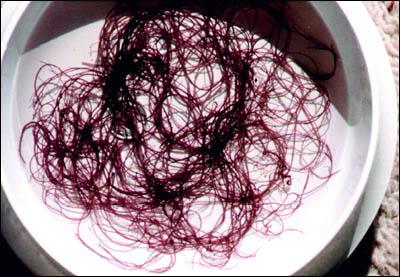
Agar
n., plural: agars
[ˈɑˌ.ɡɑɹ]
Definition: A gelatinous material obtained from certain species of algae
Table of Contents
What Is Agar?
Agar, also called agar agar, is a natural gelling agent derived from seaweed (specifically algae belonging to the class of red algae). It has been used for centuries in various cultures for its thickening and stabilizing agar properties. Agar powder is a popular ingredient in the food industry, particularly in Asian cuisine as a food additive, where it is commonly used as a “vegetarian alternative to gelatin”.
First discovered in Japan in the 17th century, agar has become an essential component in various dishes worldwide. There are three major genera from which agar is commonly harvested namely; Gelidium, Gracilaria, and Pterocladia. There are different types of agar depending on the raw material used for extraction. Agar is available in the market in the form of agar flakes, bars, and powders after its harvesting and processing methods.


If you are wondering why agar is so popular in the food industry, it’s because of its ability to gel at relatively low temperatures; it gels at around 35-40°C (95-104°F). This property makes it incredibly versatile in culinary applications as it allows the setting of liquids without the need for refrigeration. Agar is widely used to thicken soups, sauces, and desserts and to set jellies, custards, and puddings. It is also used as a stabilizer in various food products like ice cream and pastry fillings.

The use of agar is not limited to just culinary aspects, it’s also widely used in diagnostic and laboratory research works. Agar finds multiple applications in microbiology research as it serves as a solid growth medium for culturing various microorganisms. Petri dishes filled with agar-based nutrient medium (agar plates) are commonly used in laboratories to culture bacteria, fungi, and other microorganisms.
The versatility of agar is not limited to agar itself as its component “agarose” finds even more utilization in molecular biology research work! Read on till the end to find our interesting section on agarose and how this purified subsection of agar enables researchers to visualize DNA and separate DNA/RNA of different fragment sizes!
Etymology
The word “agar” has its roots in Southeast Asia, specifically in the Malay language. It is derived from the Malay word ‘agar-agar’ meaning ‘jelly’. This seaweed product has been traditionally used as an integral ingredient for making various sweet desserts, jellies, and culinary treats for centuries. The term agar-agar was eventually shortened to “agar” as it became known and used more widely outside of the Malay-speaking regions. Today, “agar” is the commonly recognized term worldwide for this natural gelling agent derived from seaweed. As the word agar traveled from its Malay origin, its association with jelly became well-established due to the gelatinous nature of the substance. This association is fitting as agar is frequently used to create a variety of jellies, desserts, custards, and other gel-based dishes in cuisines across the globe.
Watch this vid about preparing agar for microbial culture:
Biology definition:
Agar is a gelatinous material composed of two major constituents called agarose and agaropectin and derived from the cell walls of red algae of the families Gelidiaceae and Gracilariaceae. From its usage as culture media for bacterial growth and other cells to its utilization as a vegetarian food alternative for gelatin, agar finds wide utilization across various fields.
History
The history of agar is fascinating and spans centuries with its roots in East Asia where it was first discovered and used for various purposes. Look at the brief overview of the historical journey of agar through centuries.
Early Use in East Asia
Agar has a long history of use in East Asian countries, particularly in Japan, China, and Southeast Asia. Records suggest that agar was first used in Japan during the 17th century. It is believed that the Japanese were the first to discover the gelling properties of agar while cooking seaweed broth. Over time, they refined the process of extracting and drying the agar gel, turning it into a versatile ingredient for culinary purposes. An innkeeper in current Fushimi-ku (Kyoto, Japan) named Minoya Tarozaemon is credited with the discovery of agar. It is widely believed that he discovered agar in 1658 when he discarded boiled seaweed soup (called Tokoroten in Japanese). On the consecutive morning, he discovered it to be gelled on the floor which led to its widespread utilization as a common gelling agent across Asian cuisines.

Agar as a Microbiological Tool:
Agar’s journey didn’t end with its culinary uses. In the late 19th century, scientists recognized the potential of agar as a growth medium for culturing fastidious organisms in the laboratory. The German bacteriologist Robert Koch is often credited with popularizing the use of agar in microbiology in the 1880s. Agar’s ability to remain in a gel state at a “range of temperatures” made it an ideal solidifying agent for bacterial cultures (culture medium), replacing the previously used gelatin.
Agar’s stability and its ability to remain in a gel state at a broad range of temperatures allowed scientists to “maintain pure bacterial cultures” and conduct experiments with greater precision. The development of solid agar media (using different media like tryptic soy agar, blood agar, bacteriological agar, chocolate agar, MacConkey agar, and LB agar) significantly advanced the field of microbiology and contributed to the understanding of many infectious diseases.

Industrial Agar Production
As demand for agar increased worldwide, efforts were made to develop efficient methods of industrial production. In the early 20th century, Japan became a major producer and exporter of agar supplying the global market. Subsequently, other countries like Indonesia, the Philippines, and South Korea also became significant producers of agar. Currently, most agar produced by China and Japan is consumed by themselves only.

Chemical Composition
Agar occurs as a fascinating substance with a complex chemical composition. Agar’s chemical composition and unique properties make it a truly remarkable substance with diverse and valuable applications across several domains.
The main constituents of agar are “agarose” and “agaropectin”.
- AGAROSE: Agarose, the primary component, exhibits a “gel-like behavior” when dissolved in boiling water and then cooled. It is composed of repeating units of disaccharides mainly agarobiose which consists of D-galactose and 3,6-anhydro-L-galactopyranose. The chemical formula of agarose is often represented as (C12H18O9)n, where n indicates the number of repeating units. The precise value of n can vary, leading to different molecular weights and gel-forming properties.
- AGAROPECTIN: Conversely, agaropectin, a secondary component, possesses a more branched structure and is a mixture of smaller polysaccharides.
Table 1: Differences between 2 components of agar namely agarose and agaropectin | ||
|---|---|---|
| Characteristic feature | Agarose | Agaropectin |
| Nature | Linear polymer | Branched polymer |
| Percentage of agar | Constitutes 70% of agar | Constitutes 30% of agar |
| Repeating units | Agarobiose (which is further a disaccharide of 2 monosaccharides namely: D-galactose & 3,6-anhydro-L-galactopyranose) | A heterogeneous mixture of many small molecules; alternating units of D- and L-galactose both of which are heavily modified with acidic side groups (like pyruvate sulfate and glucuronate). |
| Gel-forming ability | Readily forms a gel | Doesn’t easily form a gel as compared to agarose |
| Applications | Widely used for gels for molecular biology work. | Not much commercial value |
Data Source: Dr. Harpreet Narang of Biology Online
Interestingly, agar’s source can influence its specific composition, adding to its intriguing nature. Carbon (C), hydrogen (H), and oxygen (O) are the three primary elements found in agar.
While agarose is mainly used for preparing gels for molecular biology studies, it is agar that’s mainly used as a solidifying media for microbiological work. Thanks to its ability to form a stable media at relatively low concentrations and withstand higher melting temperatures, agar finds wide-ranging applications.

Physical Properties
- Agar displays a unique phenomenon of “hysteresis”.
- It is a consequence of its behavior when mixed with water.
- At temperatures ranging from about 32 to 42 °C (305 to 315 K; 90 to 108 °F), agar solidifies and forms a gel. This is known as the gel point.
- On the other hand, agar melts at a temperature higher than 85 °C (358 K; 185 °F). This is known as the melting point.
- The difference between the gel point and the melting point temperatures is what causes the hysteresis effect in agar.
- This hysteresis property is crucial because it provides a well-balanced compromise between easy melting and maintaining a stable gel at relatively high temperatures. In scientific applications where incubation at temperatures close to the human body temperature (37 °C) is required, agar proves to be more suitable compared to other solidifying agents like gelatin which melts at such temperatures.
- The ability of agar to remain solidified at typical incubation temperatures, such as those used in microbiological studies or cell culture experiments, ensures a consistent and reliable environment for the desired processes.
- Additionally, the capacity to melt at higher temperatures makes it easy to liquefy and pour into molds or Petri dishes for preparation. This reversibility of solidification and melting makes them physical gels.

Uses
Agar finds wide utilization across fields.
Culinary
Food-grade agar finds a wide range of culinary applications.
- As a plant-based alternative to traditional gelatin, it is ideal for creating vegetarian or vegan-friendly dishes.
- Agar’s gelling properties allow chefs to set and mold various desserts like fruit jellies, panna cotta, and custards.
- It is also employed to stabilize and thicken sauces, soups, and gravies without altering flavors.
- With its ability to withstand high temperatures and remain stable at room temperature, agar is a reliable ingredient for creating beautifully textured and visually appealing dishes in both sweet and savory culinary creations.

Asian culinary
Some common Asian culinary uses of agar are:
- In Japanese cuisine: A dessert called “anmitsu” and a delicacy called “mizu yokan”
- In Philippine cuisine: For jelly bars (Samalamig, Buko pandan, fruit cocktail jelly)
- In Vietnamese cuisine: A dessert called “thach”
- In Indian cuisine: For making desserts
- In Burmese cuisine: For making “kyauk kyaw”; a sweet jelly
- In Taiwanese cuisine: For making Taiwanese bubble tea

Other culinary
Agar is also used for other culinary purposes:
- In jams and marmalades (as a replacement for pectin)
- As meat substitutes
- A good substitute for gelatin
- As a strengthening agent in soufflés and custards
- In a Russian dish called “pitch ye moloko” also called “bird’s milk” which is a rich jelly-like custard or a type of soft meringue.
- In Mexican candies (resembling melons/watermelon fruit slices)
- In Spain, used for agar sweets
- In the brewing and wine-making industry (as a clarifying agent)
Microbiology
Agar finds wide utilization in microbiological research and lab work.
Agar plate
Agar is used for preparing Petri dishes coated with agar medium. This is the choicest method for establishing a growth environment within a small Petri dish. By mixing agar with some nutrients required for the microorganisms of interest, one can culture and observe under the microscope.
An important point to note here is that agar is majorly “indigestible by most microorganisms” which ensures that the microbial growth never affects the medium and prevents its erosion.

Motility assays
Agar or agarose gel mediums offer a “porous structure” suitable for studying microorganism motility and mobility.
- The porosity of the gel depends on the concentration of agarose, allowing researchers to select different effective viscosities for their experiments.
- One common identification assay involves culturing microorganisms deep within a block of nutrient agar. Motile species can slowly migrate through the gel, revealing infiltration rates. Non-motile species will only grow along the path created by the initial sample deposition.
- For measuring chemotaxis and chemokinesis, the under-agarose cell migration assay is often employed. Here, a layer of agarose gel separates a cell population from a chemoattractant. As the chemoattractant diffuses into the gel, a concentration gradient forms, and microphotography captures various cell populations migrating upward against gravity along the gradient, showcasing different stimulation levels required for migration.

Plant Biology
In the field of plant biology, research-grade agar is widely used for several purposes as discussed below.
» For seed germination: Due to its ability to support seedling germination under sterile conditions in Petri dishes, agar supplemented with a nutrient and/or vitamin mixture supports the successful germination of sterilized seeds.
» For growing sterile plants: For growing model plants like Arabidopsis thaliana for plant molecular biology work, agar supplemented with Murashige & Skoog (MS) nutrient mix and Gamborg’s B5 vitamin mix is the most apt.
One important point to keep in mind: To ensure proper solidification of the agar in any growth medium, it is important to consider the pH levels. The optimal range for solidification lies between 5.4 and 5.7. If needed, potassium hydroxide (KOH) is applied to adjust the pH to this range. This growth medium allows for the precise application of phytohormones and other substances to induce specific growth patterns in plants.

Other uses
There are several other uses of agar as discussed below.
- Dentistry (impression material)
- Histopathology processing (for orienting tissue specimen in agar pre-embedding)
- Electrochemistry (for making salt bridges & gel plugs)
- Kid’s toys (for making modeling clay)
- Agriculture (as a biofertilizer)
- Immunology research (substrate for precipitin reactions)
NOTE IT!
Agar versus Agarose: What’s best for molecular biology work?
Agarose is a “purified subsection of agar” that plays a crucial role in molecular biology research. Its unique properties make it an essential tool for visualizing DNA and separating DNA/RNA fragments of different sizes.
- In gel electrophoresis, a common technique used to separate DNA and RNA molecules based on their size, agarose gel serves as the matrix through which the molecules migrate.
- Agarose gels also enable the visualization of DNA fragments. By adding a fluorescent dye or a DNA intercalating agent to the gel, the DNA bands can be visualized under ultraviolet (UV) light.
- Moreover, agarose gel electrophoresis is invaluable in techniques like polymerase chain reaction (PCR), restriction enzyme analysis, and DNA sequencing. The ability to separate and analyze nucleic acids based on their size contributes significantly to understanding genetic information, diagnosing diseases, and advancing various biotechnological applications.
So, agarose is the preferred choice for most molecular biology work.

Some of the most supreme advantages of agarose that make it the go-to option for molecular biology applications are:
- Purity: Agarose is a highly purified form of agar, which means it has fewer impurities and contaminants. This purity ensures a clean and reliable matrix for DNA and RNA separation without interference from unwanted substances.
- Gel Strength: Agarose gels have significantly better gel strength and clarity as compared to agar gels.
- Size Range: Agarose gels provide a broader range of separation capabilities, particularly for large DNA fragments. They can effectively separate nucleic acid molecules of varying sizes, from a few hundred base pairs to several thousand base pairs.
- Ease of Use: Agarose gels are easy to prepare and handle. They dissolve readily in water, and their gelation process is straightforward, requiring minimal preparation time.
- Reproducibility: Due to its purity and consistent properties, agarose offers better reproducibility in experimental results. Researchers can rely on consistent gel performance across different experiments.
- Compatibility: Agarose gels are compatible with a wide range of molecular biology techniques, including gel electrophoresis, DNA sequencing, PCR, restriction enzyme analysis, and more.
While agar can still be used in certain applications, especially in microbiological media and other non-genetic studies, agarose is the preferred choice when working with DNA, RNA, and other nucleic acids. Its superior gel-forming properties and purity make it the best option for accurate and reliable molecular biology work.
Take the Agar – Biology Quiz!
References
- Armisen, R., & Galatas, F. (1987). Production, properties and uses of agar. Production and utilization of products from commercial seaweeds. FAO Fish. Tech. Pap, 288, 1-57.
- National Center for Biotechnology Information (2023). PubChem Compound Summary for CID 71571511, Agar. https://pubchem.ncbi.nlm.nih.gov/compound/Agar.
- Thiviya, P., Gamage, A., Liyanapathiranage, A., Makehelwala, M., Dassanayake, R. S., Manamperi, A., … & Madhujith, T. (2022). Algal polysaccharides: Structure, preparation and applications in food packaging. Food Chemistry, 134903.
- Mischnik, A., Mieth, M., Busch, C. J., Hofer, S., & Zimmermann, S. (2012). First evaluation of automated specimen inoculation for wound swab samples by use of the Previ Isola system compared to manual inoculation in a routine laboratory: finding a cost-effective and accurate approach. Journal of clinical microbiology, 50(8), 2732-2736.
- Santos, R., & Melo, R. A. (2018). Global shortage of technical agars: back to basics (resource management). Journal of applied phycology, 30(4), 2463–2473. https://doi.org/10.1007/s10811-018-1425-2
- González-Leija, J. A., Hernández-Garibay, E., Pacheco-Ruíz, I., Guardado-Puentes, J., Espinoza-Avalos, J., López-Vivas, J. M., & Bautista-Alcantar, J. (2009). Optimization of the yield and quality of agar from Gracilariopsis lemaneiformis (Gracilariales) from the Gulf of California using an alkaline treatment. Journal of applied phycology, 21, 321-326.
- Liu, J., & Gu, H. (2021). Biotechnological production of ssDNA with DNA-hydrolyzing deoxyribozymes. STAR protocols, 2(2), 100531.
- Cao, L., & Li, N. (2021). Activated-carbon-filled agarose hydrogel as a natural medium for seed germination and seedling growth. International Journal of Biological Macromolecules, 177, 383-391.
©BiologyOnline.com. Content provided and moderated by Biology Online Editors.








